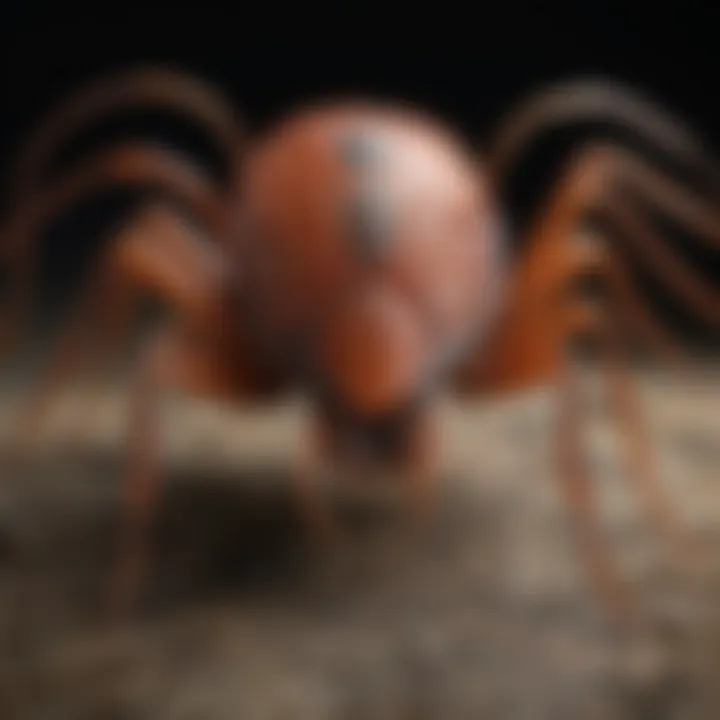Understanding Tick Infestation: Insights and Management


Intro
Tick infestations have increasingly emerged as a pressing concern for various stakeholders, impacting both human health and woodland ecosystems. Understanding the biological and ecological dynamics of ticks provides essential insights into effectively managing their populations. This article explores the complex relationships within woodland ecosystems, sustainable forestry practices, and management techniques that can mitigate the detrimental effects of ticks.
Understanding Woodland Ecosystems
Importance of Biodiversity in Forests
Forests are among the most biodiverse ecosystems on the planet. They harbor a multitude of species, including trees, plants, animals, and microorganisms. Maintaining this biodiversity is crucial for ecological balance. Biodiversity in forests contributes to resilience against pests like ticks. A diverse range of species can limit tick populations through natural predation and competition.
Role of Forests in Climate Regulation
Forests play a vital role in the global climate system. They act as significant carbon sinks, absorbing carbon dioxide from the atmosphere. This process mitigates climate change impacts. Healthy forest systems regulate temperatures and improve local air quality. When tick populations surge, this natural balance can be disrupted, leading to increased risk of tick-borne diseases among wildlife and humans.
Sustainable Forestry Practices
Principles of Sustainable Forestry
Sustainable forestry seeks to balance forest use with ecological preservation. This involves managing forest resources to meet current needs without compromising future generations. Best practices include selective logging, maintaining wildlife habitats, and ensuring reforestation. These principles create healthier ecosystems that can inherently manage tick populations more effectively.
Case Studies of Successful Implementations
Examples around the world showcase sustainable forestry practices that have notably reduced tick infestations. For instance, a study conducted in the northeastern United States displayed how employing selective harvesting methods improved forest biodiversity. As a result, wildlife had fewer tick infestations, demonstrating the interconnectedness of species within these ecosystems.
Woodland Stewardship Techniques
Forest Management Plans
A robust forest management plan is essential for effective stewardship. These plans outline specific strategies for maintaining forest health, minimizing infestations, and enhancing biodiversity. They often include provisions for regular monitoring of tick populations and targeted interventions when necessary. By focusing on long-term health, these plans support both human safety and ecological well-being.
Conservation Strategies
Implementing conservation strategies can greatly mitigate the impact of ticks. Protected areas can serve as refuges for natural predatory species that regulate tick populations. Furthermore, educating forest users about tick prevention can enhance local community involvement in sustainable practices. Initiatives that promote awareness of ecological health create a culture of stewardship.
Effective management of tick infestations requires an understanding of both ecological dynamics and human practices.
Intro to Tick Infestation
Tick infestation is a growing concern in both human health and woodland management. Understanding the behavior and presence of ticks is essential for forest stewardship and for ensuring the well-being of the population. Tick infestations can lead to various diseases, which can have serious implications for health and ecosystems alike.
Recognizing the signs and impacts of tick infestation is crucial. The consequences of not addressing this issue can lead to significant health risks, including persistent ailments related to tick-borne diseases. Moreover, ticks play an intricate role in the ecosystem, influencing the dynamics of wildlife populations and plant life. Thus, understanding ticks not only helps in managing health risks but also contributes to the preservation of forest ecosystems.
Defining Tick Infestation
Tick infestation refers to the presence of ticks on humans, animals, or plants that results in their feeding and possible transmission of pathogens. Ticks are small arachnids that, when active, attach themselves to hosts by inserting their mouthparts into the skin to feed on blood. Infestation can vary in severity depending on factors like tick species and host susceptibility.
Infestations can occur in various environments. Notably, areas with dense vegetation and high humidity provide optimal conditions for ticks. As such, understanding the definition of tick infestation helps in identifying at-risk populations and environments.
The Importance of Understanding Ticks
There are various reasons why understanding ticks is significant. One of the primary considerations is the health implications associated with tick bites. Tick-borne diseases, such as Lyme disease and Rocky Mountain spotted fever, are on the rise in many regions. By understanding the life cycle and behavior of ticks, individuals can better recognize prevention strategies.
Moreover, understanding ticks also aids in effective management practices in woodland care. Ticks are an integral part of the ecosystem. However, their population can become problematic if left unchecked. Thus, combined knowledge about ticks can lead to better conservation efforts, safeguarding both wildlife and public health. It is essential to approach tick management with informed strategies that balance ecological health with human safety.
Biology and Behavior of Ticks
Understanding the biology and behavior of ticks is critical for managing their infestations effectively. This knowledge helps shed light on their ecological roles, life cycles, and interaction with hosts. It can inform better strategies to control tick populations and prevent their harmful impact on both human and animal health. Knowledge of tick biology guides forest stewardship, particularly in environments susceptible to these pests.
Tick Species Overview


Ticks belong to the arachnid class and there are several species that can affect mammals, birds, and even reptiles. The two primary families of ticks are Ixodidae, also known as hard ticks, and Argasidae, known as soft ticks. Each family has distinct characteristics.
- Hard Ticks: These include species like the blacklegged tick (Ixodes scapularis) and the lone star tick (Amblyomma americanum). They have a scutum, or hard shell, which contributes to their resilience against environmental factors.
- Soft Ticks: These include the common bed bug tick (Ceratophyllus gallinae). Soft ticks appear rounded and leathery, lacking the hard backing seen in hard ticks.
Both families are vectors for tick-borne diseases and understanding their variations is crucial in managing infestations.
Life Cycle of Ticks
Ticks undergo a complex life cycle consisting of several stages: egg, larva, nymph, and adult. Each stage requires a blood meal to develop into the next phase.
- Egg Stage: Female ticks lay thousands of eggs, which typically hatch into larvae in a few weeks.
- Larval Stage: Larvae must feed on a host to progress. They often seek small mammals, using sensory organs to detect hosts.
- Nymph Stage: After feeding, larvae molt into nymphs, which are more aggressive feeders. Nymphs can transmit diseases as they seek larger hosts, including humans.
- Adult Stage: After a final blood meal, nymphs mature into adults. Mating occurs, which starts the cycle anew.
Understanding these stages helps in timing interventions to reduce tick populations effectively.
Behavioral Patterns in Ticks
Tick behavior is closely tied to their survival and reproductive strategies. Each species exhibits unique patterns but certain general behaviors can be observed:
- Questing: Ticks engage in questing when they search for hosts. They climb onto vegetation and extend their limbs. This behavior peaks in warmer months when hosts are more active.
- Host Selection: Many ticks are opportunistic feeders. They often utilize environmental cues, such as carbon dioxide or warmth, to locate hosts. Understanding these cues aids in developing repellent strategies.
- Survival Tactics: Ticks can survive long periods without feeding. Some species can even enter a state of dormancy during unfavorable conditions. This resilience means that tick eradication efforts need to be persistent and strategic.
Understanding these behaviors enables the formulation of targeted management practices, possibly diminishing tick populations near human habitats.
In summary, comprehending the biology and behavior of ticks is paramount for effective management and prevention strategies. With few effective control measures available, it is vital that we leverage our knowledge of tick behavior for better outcomes.
Health Implications of Tick Infestation
Tick infestation represents a pressing health concern that can have serious implications for people and their pets. Understanding these health risks is critical for those who live in or frequent wooded areas. Ticks are vectors for numerous diseases, some of which can be debilitating or even life-threatening. The significance of addressing health implications lies not only in prevention but also in timely intervention should an infestation occur.
Common Tick-Borne Diseases
Ticks are infamous for transmitting a range of illnesses. Lyme disease, caused by the bacteria Borrelia burgdorferi, is one of the most well-known afflictions, characterized by symptoms such as fatigue, headache, and a distinct skin rash known as erythema migrans. Other common tick-borne diseases include:
- Anaplasmosis: Resulting from Anaplasma phagocytophilum, affects white blood cells and can lead to fever and chills.
- Rocky Mountain spotted fever: Caused by Rickettsia rickettsii, this disease presents with severe headaches, rash, and can lead to serious complications.
- Babesiosis: A malaria-like disease caused by Babesia sp., leading to flu-like symptoms including fever and muscle pain.
A thorough understanding of these diseases is crucial for effective prevention and control measures.
Symptoms and Diagnosis
The symptoms of tick-borne diseases can vary widely, making diagnosis challenging. Early detection is essential for effective treatment. Symptoms often mimic other health issues, which can lead to misdiagnosis. Key symptoms include:
- Fever and chills
- Muscle and joint aches
- Fatigue
- Headaches
In suspected cases, healthcare providers may rely on a combination of patient history, symptoms evaluation, and laboratory tests. A history of tick exposure is a significant factor that may guide the diagnostic process. Remember that the earlier a tick-borne disease is diagnosed, the more effective the treatment options may be.
Long-Term Health Effects
The consequences of untreated tick-borne diseases can be severe, with some individuals experiencing lasting effects. For example, Lyme disease can lead to Lyme arthritis or chronic disorders if not treated promptly. Other potential long-term health effects associated with tick infections include:
- Neurological issues, like memory problems and difficulty concentrating
- Joint inflammation and chronic pain
- Fatigue that persists long after the initial infection has cleared
It is imperative to take tick infestations seriously and to understand the long-term risks associated with tick-borne diseases. Awareness and preventive measures are key components in safeguarding health against these hidden threats.
Timely intervention during tick-infested seasons is paramount for reducing the impact of tick-borne diseases.
Ecological Roles of Ticks
Ticks, often considered mere pests, play crucial roles in our ecosystems. Understanding these ecological roles is vital for forest stewardship and conservation. Ticks contribute to the health of woodland environments, often influencing the dynamics of both prey and predator populations. Their presence in a habitat can impact animal behavior, population dynamics, and even biodiversity.
Ticks in the Food Web
Ticks occupy a unique position in the food web. They serve as ectoparasites, feeding on the blood of various mammals, birds, reptiles, and amphibians. In this capacity, ticks can influence host populations by affecting their health and survival.


- Prey for Predators: Some species of small mammals and birds feed on ticks, incorporating them into their diet. This creates a link between ticks and higher trophic levels, showcasing their interconnectedness within the ecosystem.
- Nutrient Cycling: By feeding on hosts and later being consumed themselves, ticks can contribute to the nutrient cycle within the forest ecosystem. When they die, their bodies return nutrients to the soil, supporting plant growth.
Ticks also exhibit a behavioral adaptation; they can alter the movement of their host species to ensure their survival and propagation. Some hosts may avoid heavily infested areas, indirectly influencing the vegetation and animal distribution.
Impact on Biodiversity
Ticks can have both positive and negative effects on biodiversity. On one hand, the presence of ticks encourages a balance between different species in an ecosystem. For example, host animals that are more resistant to tick infestations may thrive, while less resistant individuals may decline. This creates natural selection, enhancing genetic diversity over time.
- Species Interactions: Many species have developed specific adaptations in response to tick infestations. Such responses may include behavioral changes, immunological adaptations, and variations in habitat preferences. This interaction demonstrates the complexity of ecological relationships and the vital role ticks, albeit indirectly, play in shaping these dynamics.
- Disease Regulation: Ticks can also affect the biodiversity of ecosystems through the transmission of diseases. The diseases they carry can impact certain animal populations disproportionately, potentially leading to a decline in specific species and, consequently, affecting biodiversity.
Ticks and Ecosystem Health
The health of ecosystems can be closely tied to the presence and behaviors of ticks. Their role in both the ecological balance and disease dynamics emphasizes why they should not be overlooked in ecosystem assessments.
- Indicators of Ecosystem Change: Ticks can serve as bioindicators, revealing changes in ecosystem health due to factors such as climate change or habitat destruction. Changes in tick populations or behavior may signal shifts in biodiversity or the presence of environmental stressors.
- Ecosystem Resilience: Ecosystems that maintain a balanced tick population may be more resilient against invasive species and able to sustain a healthy level of biodiversity. Tick management can thus play a part in maintaining the overall health and resilience of woodland ecosystems.
"Understanding the ecological roles of ticks allows for holistic approaches to forest management and disease control. A well-rounded perspective can lead to more sustainable practices."
Identifying Tick Infestations
Ticks are a hidden threat often overlooked until the problems arise. Identifying tick infestations is crucial for both human and animal health, as well as woodland ecosystem integrity. Awareness and understanding of infestation signs lead to timely interventions, reducing the risk of bite-related diseases.
Signs of Infestation in Humans
Ticks can be a severe public health issue. When assessing for tick bites or infestations, individuals should look for the following:
- Rashes: A classic sign is a rash, especially a bulls-eye rash indicative of Lyme disease.
- Itching and Redness: These can develop shortly after a tick attaches.
- Flu-like Symptoms: Headaches, fatigue, and fever can appear within days of infestations.
Regular body checks after outdoor activities are essential, particularly in areas known for ticks. Early prevention can significantly decrease potential health complications.
Signs of Infestation in Animals
Pets and livestock serve as hosts for ticks, making it vital to monitor their health. Key signs include:
- Excessive Scratching or Biting: Animals may try to relieve the irritation caused by tick bites.
- Visible Ticks: Checks should include fur areas such as the ears and between toes.
- Behavior Changes: An increase in restlessness or shifts in normal behavior can signal a problem.
Understanding these signs can encourage quick veterinary treatment, thereby preventing more serious health issues for pets and livestock.
Detecting Infestations in Woodlands
Woodlands are a prime environment for ticks, and recognizing infestations there is fundamental for forest stewardship. Here are strategies to detect ticks:
- Environmental Checks: Assess areas with dense underbrush or tall grass, where ticks thrive.
- Wildlife Monitoring: Observe animal tracks. An increase in some animals might indicate higher tick populations.
- Tick Dragging: Use a white cloth to drag through suspected areas, noting any ticks that cling to the fabric.
Understanding infestation signs in woodland areas can lead to effective management tactics that protect both ecosystems and public health.
Being vigilant about identifying tick infestations can save health complications and support the continuous health of woodland environments.
Management Strategies for Tick Infestation
Managing tick infestation is critical for maintaining both public health and ecological balance. Effective management strategies not only reduce tick populations but also limit exposure to tick-borne diseases. This section discusses integrated pest management, preventive measures, and treatment options, offering practical insights for forestry professionals and conservationists. The outcomes of these strategies are essential for informed decision-making in forest stewardship, as they provide methods to control tick populations while fostering healthy woodland ecosystems.
Integrated Pest Management
Integrated Pest Management (IPM) is a holistic approach that combines different strategies to effectively manage tick populations. This method emphasizes the use of a variety of techniques rather than relying on a single pesticide application. The key elements of IPM in the context of ticks include:
- Monitoring: Regular surveillance of tick populations helps identify infestation hotspots. This can involve checking for ticks in specific areas and observing animal populations that may harbor ticks.
- Cultural Practices: Modifying the environment to reduce ticks is a vital step in IPM. For instance, maintaining lawn areas and creating barriers can prevent ticks from entering high-risk zones.
- Biological Control: Utilizing natural predators, such as certain types of nematodes, can help reduce tick numbers.
- Chemical Controls: In cases where infestations are severe, targeted pesticide use may be necessary. It is crucial to select products that minimize harm to non-target organisms and the environment.
IPM promotes a balance between eradicating ticks and preserving biodiversity, thus playing a significant role in sustainable forest management.
Preventative Measures


Prevention is the foremost strategy for tick management. It involves both personal protection and environmental modifications. Effective preventative measures include:
- Personal Protection: Forestry professionals should wear light-colored clothing to easily spot ticks. Tucking pant legs into socks and applying insect repellent that contains DEET can also be beneficial.
- Landscape Management: Reducing tall grass and dense shrubbery can decrease tick habitats. Keeping wood piles and leaf litter away from recreational areas can further minimize exposure to ticks.
- Fencing: Installing fencing around woodland areas can deter wildlife, like deer, that carry ticks into these environments.
- Tick Checks: Performing regular tick checks after spending time outdoors reduces the chance of ticks attaching to skin unnoticed.
Educating the public and professionals about these preventative measures enhances community awareness and reinforces proactive engagement in tick management efforts.
Treatment Options for Infestations
When tick populations exceed acceptable levels, treatment becomes necessary. The treatment options can include a range of strategies to effectively control infestations:
- Targeted Pesticide Application: This involves applying pesticides specifically in areas where ticks are most prevalent. It's essential to follow the manufacturer's guidelines to ensure safety.
- Mechanical Controls: Removing ticks by physically dislodging them from the environment is also possible. For instance, using vacuum devices can help in certain scenarios.
- Professional Pest Management Services: Engaging experts who specialize in pest control can provide tailored solutions based on specific needs.
"An integrated approach that combines effective prevention and treatment options reduces the risk of tick infestations and makes woodlands safer for both humans and wildlife."
By implementing these strategies, forestry professionals can lead efforts not only to lower tick populations but also to ensure a healthier interaction between human activities and woodland ecosystems.
Best Practices for Tick Management in Woodland Stewardship
Effective tick management is essential within the context of woodland stewardship. This practice not only mitigates the risks associated with tick-borne diseases but also promotes healthier ecosystems. Managing tick populations requires a multifaceted approach. By understanding the dynamics of tick biology and behavior, stewardship initiatives can implement strategies that minimize infestation risks.
Focus on creating environments that deter ticks. This includes establishing landscape features that interrupt their habitat. Additionally, land managers must consider the ecological balance during tick management. An effective strategy will also take into account the biodiversity of the area, ensuring that management practices do not adversely affect non-target species. The collaborative efforts of the community, landowners, and forest professionals also become vital in promoting a collective responsibility toward tick management.
Creating Tick-Resistant Environments
Developing tick-resistant environments involves several key elements. First, landscape manipulation can significantly reduce tick populations. This includes:
- Maintaining clear paths through woodlands to reduce tick contact with humans and pets.
- Regular trimming of vegetation helps to minimize high-density areas where ticks can thrive.
- Creating barriers with natural materials can inhibit tick movement between differing habitats.
Another consideration is managing wildlife populations. Certain animals may serve as hosts for ticks. By understanding wildlife dynamics, land managers can shape environments that discourage tick hosts from frequenting specific areas. Additionally, prioritizing native plant species can foster a healthier habitat that naturally resists tick populations.
It is critical to regularly monitor and evaluate the effectiveness of these environmental strategies. Adjustments may be necessary based on observed tick activity patterns in the woodland. Incorporating research and findings from entomological studies can offer valuable insights for improving these environments further.
Community Engagement and Education
Community engagement and education play a pivotal role in tick management efforts. A collective understanding of ticks, the diseases they may carry, and preventative measures can empower local communities. Educational initiatives should emphasize the importance of:
- Awareness of tick-borne diseases, including Lyme disease and ehrlichiosis, and how to identify symptoms early.
- Preventative strategies, such as wearing protective clothing and using repellent during outdoor activities.
- Engagement programs that encourage community participation in monitoring tick populations and conducting surveys.
Organizing workshops, seminars, and community events can increase awareness of best practices in tick management. Collaboration with local health departments and environmental agencies provides critical resources for educational campaigns.
Engaging the community fosters a sense of shared responsibility for managing tick populations and protecting public health.
Creating educational materials that outline best practices and distribute them through local channels, such as schools, community centers, and social media, can enhance outreach.
In summary, the dual approach of creating tick-resistant environments and ensuring community engagement forms a robust framework for effective tick management in woodland stewardship. By combining environmental modifications with communal efforts, it is possible to improve health outcomes and support ecological integrity.
Ending
Understanding the various facets of tick infestation is crucial for managing both the health of humans and the integrity of woodland ecosystems. This section consolidates the insights presented throughout the article, emphasizing the importance of proactive management strategies and informed practices. It becomes evident that ticks, while often viewed solely as pests, play complex roles within their environments, necessitating a nuanced approach to their control and mitigation.
Summary of Key Points
- Ticks have ecological significance, impacting wildlife and plant health.
- Their biology and behavior reveal how they thrive in various environments, which informs management strategies.
- Tick-borne diseases present serious health risks, highlighting the need for awareness and preventive measures.
- Effective management encompasses integrated pest management and community engagement, crucial for long-term sustainability.
Overall, the article illustrates that addressing tick infestations is not merely about eradication but involves understanding ecological dynamics and promoting resilience within ecosystems.
Future Directions in Tick Research
Looking ahead, research on ticks should prioritize several areas:
- Genomic analysis of tick species to understand their evolution and adaptability.
- Ecological studies that assess how climate change affects tick populations and behaviors.
- Innovative control measures, including biological control methods, that can reduce reliance on chemical pesticides.
- Public health research focused on identifying emerging tick-borne diseases and their vectors.
- Education strategies leveraging technology to raise awareness about ticks and their management.
By concentrating on these areas, researchers and practitioners can better equip communities to deal with tick infestations effectively.
"As we advance our understanding of ticks, we stand to significantly improve both human health outcomes and ecological balance."
Engagement with the scientific community and stakeholders is essential for implementing findings from tick research effectively.







